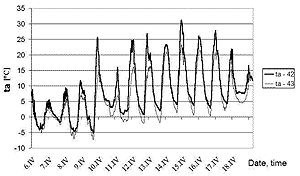INFLUENCE OF WHITE FLEECE ON THE YIELD FORMATION OF EARLY POTATOES
Karel HAMOUZ, Petr DVOŘÁK
Czech University of Agriculture in Prague, Faculty of Agronomy, 165 21 Prague 6 - Suchdol, Czech Republic (contact e-mail: hamouz@af.czu.cz)
Introduction
A fleece of type Agryl could advance early potatoes harvest by 7 - 10 days according to Jaša (1994) andincreasea yield by 20 % and more. Bizer (1994), Jansta and Garčicová (1997), Lutomirska (1995) arrived at similar conclusions. There are good experiences with the fleece used for vegetables and early potatoes abroad and in recent years also in the Czech Republic. The fleece creates optimum climate for germination and plant growth and maintains more favourable temperature during cold weather (Bizer, 1997). Fleece costs are about 1000 - 1200 EUR.ha-1, but with usual double use during operating tests it has still paid off to Czech growers. Favourable economical results for the fleece use for early potatoes ascertained Prosba-Bialczyk (2000).
Material and methods
Influence of white fleece Pegas-agro 17 UV on dynamic of watered early potatoes yield formation was monitored in precise field experiments during 1999 - 2001. At Přerov nad Labem site (early potato region of Czech Republic) very early cultivars Adora and Impala were cultivated according to methodology of central institute for Supervising and Testing in Agriculture. Fleece was placed on ridges immediately after planting (30.3.1999, 4.4.2000 and 5.4.2001) and removed 18.5.1999, 4.5.2000 and 10.5.2001. Herbicide Sencor 70 WP was applied on ridges in rate of 0.5 kg.ha-1 after planting and before fleece was placed. Each year samplings of plant in order to evaluate a level of yield components according to dates in table 1. The same experiments continued in 2003 when also an air temperature above soil surface was measured (by sensors integrated in datalogger Minikin TH).
Results and discussion
Achieved results confirm distinctly positive influence of the fleece on tuber yield in early harvesting terms. Table 1 and table 2 indicate that in option with fleece tuber yield statistically confirmatively exceeded tuber yield of control option.
Table 1: Ware Size Tuber Yield for Cultivar Adora
| Date of Harvest | Yield (t.ha-1) |
| Control (C) | Fleece (F) | Difference F - C | LSD = 5 % | F/C (%) |
| 2.6.99 | 11.76 | 17.23 | 5.47 | 2.02 | 146.5 |
| 31.5.00 | 16.89 | 19.40 | 2.51 | 2.12 | 114.9 |
| 7.6.01 | 18.96 | 23.59 | 4.63 | 3.46 | 124.4 |
Favourable influence of white fleece on yield level at early terms of potatoes harvest was connected with artificially created microclimate conditions, which advanced sprouting by seven up to ten days compared to control and accelerated further growth and crops development when weather conditions were less favourable for early potatoes. It is confirmed by results of temperature measurements in ground layer in 2003 (Picture 1). Significantly higher values are apparent for daily temperature maximums and also higher values of minimums for crops under fleece (ground temperature average during crops shielding from 3.4. to 17.5.03 was 8.4oC and for unshielded crops it was 5.8oC). In days with minimums around -7oC and especially on 12th, 13th and 14th of April 2003 heat insulating effect of the fleece manifested itself clearly when temperature under the fleece was nearly by 3oC higher and above freezing point compared to unprotected crops.
During three experimental years the fleece had in the first term of harvest the highest yield effect in 1999 (on average of both cultivars yield gain was compared to control in 1999 52.6%, in 2000 21.3% and in 2001 33.7%). It is connected with daily air temperatures in April and May when in 1999 it was colder weather and the fleece was covering crops for 49 days while during 2000 and 2001 the fleece was removed 30 (35) days after sprouting (at that time average daily temperatures were highly above 20oC and the fleece started to influence rather negatively microclimate of crops). Table 1and 2 indicate that higher yield effect of fleece was in cultivar Impala.
Table 2: Ware Size Tuber Yield for Cultivar Impala
| Date of Harvest | Yield (t.ha-1) |
| Control (C) | Fleece (F) | Difference F - C | LSD = 5 % | F/C (%) |
| 2.6.99 | 8.88 | 14.08 | 5.20 | 2.38 | 158.6 |
| 31.5.00 | 15.53 | 19.81 | 4.28 | 1.87 | 127.6 |
| 7.6.01 | 12.74 | 18.21 | 5.47 | 1.97 | 142.9 |

Figure 1: Air Temperatures for Uncovered Potatoes (ta-43) and for Potatoes Covered with Fleece (ta-42)
Conclusion
Achieved results proved that use of the white fleece is an important intensification factor for watered early potatoes cultivation at early harvest terms. In our experiments on May and June during three year average of both cultivars the fleece increased a yield by 35.8% compared to control. Its yield effect is influenced by weather conditions of the year (higher effect in years with cold weather in spring) and by cultivar (cultivar Impala had higher yield gain compared to cultivar Adora). Favourable influence of the fleece on temperatures of ground layer was demonstrated and also heat insulating effect of the fleece during ground frosts was proved.
Literature
Bizer, E.: Fruhkartoffelanbau unter Vlies und Folie. Kartoffelbau, 45, 1994, č. 12, s. 462-466.
Bizer, E.: Ernteverfruhung durch Vliesabdeckung. Kartoffelbau, 48, 1997, č. 1/2, s. 60-61.
Jansta, Z. - Garčicová, L.: Velmi rané brambory. Úroda, 45, 1997, č. 3, s. 36-37.
Jaša, B.: Využití netkaných textilií v zahradnictví. Polygraf Znojmo Blažek a Vrátil, 1994, s. 20-21.
Lutomirska, B.: Stosowanie agrowlokniny dla przyspieszania plonowania ziemniakow. Ziemniak Polski, 1995, č. 3, s. 14-19.
Prosba-Bialczyk, V. - Paluch, F. - Mydlarski, M.: Efektywnosc ekonomiczna produkcji ziemniaków wczesz nych pod agrowloknina przy zroznicowanej obsadzie. In: Ziemniak spozywczy i przemyslowy oraz jego przetwarzanie. Konf. nauk., Wroclaw - Polanica-Zdrój, 2000, s. 187-188.
This study was supported from project of the Nacional Agency for Agricultural Research No. QE 1174
|

